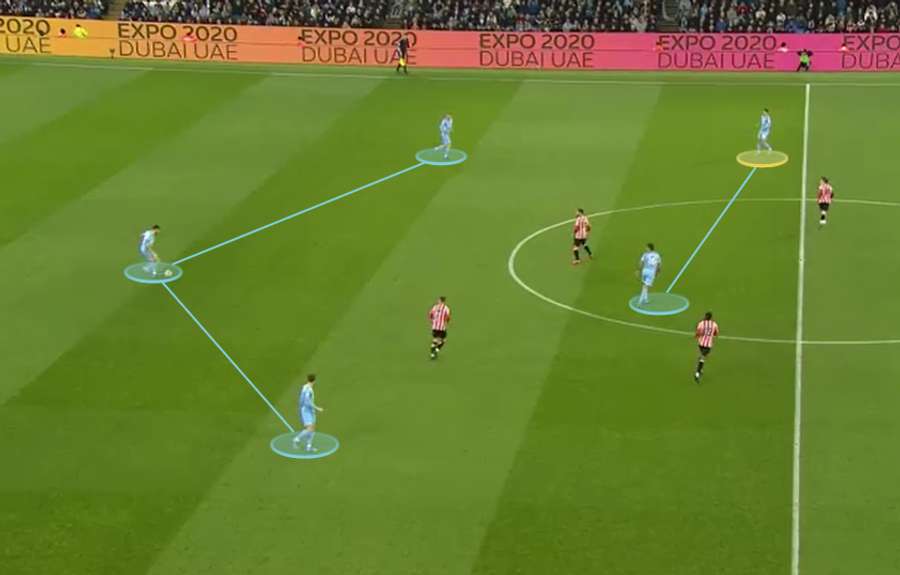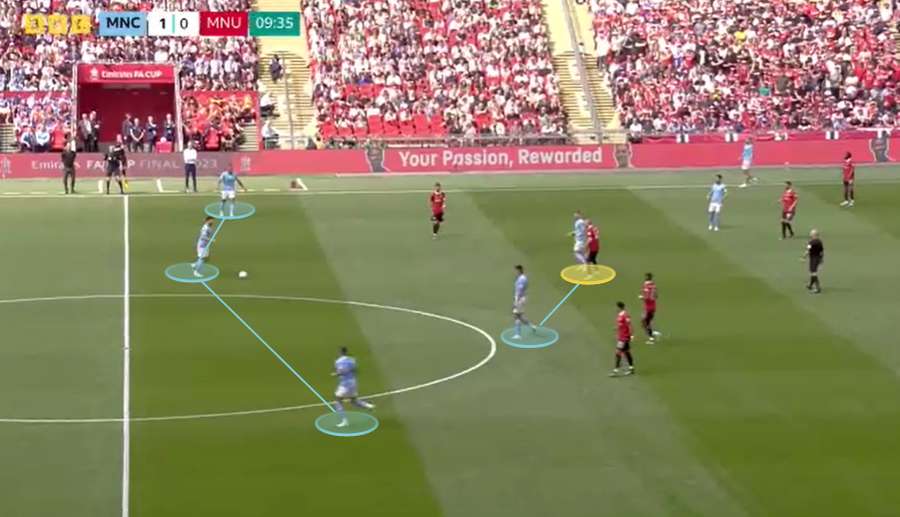On Saturday, they took one step closer to becoming the first English club since Manchester United in 1999 to secure a historic league, cup and Champions League treble - by deliciously defeating their arch-rival rivals 2-1 at Wembley.
Goals from midfielder Ilkay Gundogan delivered the FA Cup, but the German’s impressive brace was upstaged on the day by the standout display of his teammate, John Stones. The England international was once again the essential cog in City’s dominant performance as he executed his ever-impressive fluid defensive/midfield role exquisitely.
Throughout his eight-year tenure in charge at Etihad, Guardiola has consistently evolved his side. And one of the more obvious evolutions we’ve seen in recent seasons is turning his familiar 4-3-3 formation into something closer to a 3-2-4-1 in possession.
The benefit is that it theoretically adds an extra midfielder into the centre of the pitch, often creating a numerical overload which is a huge advantage for possession-focused teams who look to dominate the ball.
Previously, Guardiola had been doing this by moving a full-back inside. He started the process predominantly utilising Oleksandr Zinchenko or Joao Cancelo who’d often invert to take up more central locations.

Both have since departed, although, the former now plays a similar role for Arsenal under Mikel Arteta, and indeed we’ve seen other top coaches from around the world mirroring Guardiola’s approach.
Jurgen Klopp is another who has been imitating it to great success by using Trent Alexander-Arnold in a hybrid inverted full-back role - as we at Flashscore covered recently here.
Despite the departure of those well-suited profiles, Guardiola did for a spell continue to deploy that same system by using City Academy graduate Rico Lewis as his inverted full-back. The teenager fulfilled the role well, but - perhaps as a consequence of other sides replicating the structure - Guardiola has opted to move away from the approach in recent months.
We’re now seeing Man City start matches with no full-backs and instead with three - sometimes even four - centre-backs in their defence. Of those defenders, it is now Stones who is given license to step out of the backline and provide the team with that extra player in the build-up phase. The three remaining defenders, meanwhile, will contract to form a robust back three.

It’s an approach that’s proven to not only be highly effective for City but also one that rivals will struggle to replicate because of the unique standout capabilities of Stones. Guardiola labelled the England international an “incredible player” following Saturday’s FA Cup success, and he’s right, because it’s hard to think of another central defender who possesses his composure and ability in possession.
In the Premier League this season, no City player could better his pass success rate of 93 per cent. Additionally, Opta have the defender down as miscontrolling the ball on just eight occasions all season, while being dispossessed on just four.
Because of his brilliance on the ball, Stones stepping out of the defence has been causing opponents big problems. They can’t afford to allow him freedom on the ball, but as a consequence of trying to close him down, City’s dangerous attacking midfielders ahead are flourishing by occupying the spaces that open with the defensive structures that unravel in front of them.
Gundogan is a fine example of that - his brace on Saturday means he has registered eight goal contributions across his last six appearances (G6, A2), while in no other season has he received more Premier League passes (2074) or progressive passes (163).
It’s just not with the ball, though, that Stones’ new role has had a hugely positive impact on City, but without it, too. Guardiola’s side tend to commit plenty of players forward in attacking moves, which can - and has in previous seasons - left them vulnerable to counter-attacks.
In previous years when the ball would be turned over, City’s inverted full-back would have more ground to cover as they retreated into their natural wider position. Now, however, Stones is making shorter vertical moves to drop back into a central position, helping to turn that defensive three into a robust four quickly.
We can see the benefits of this by looking at the changes in the opposition’s success in moving up the pitch this season. In the last campaign, opponents averaged 10.9 metres of progression per possession sequence. That’s fallen to 9.8 this season which is the lowest in the Premier League.
There’s going to be so much to admire and analyse about this City side should they seal a remarkable treble with victory over Inter Milan in the Champions League final on Saturday. However, when reflecting, the role of John Stones should be considered one of the biggest influencing factors in helping them achieve it.




